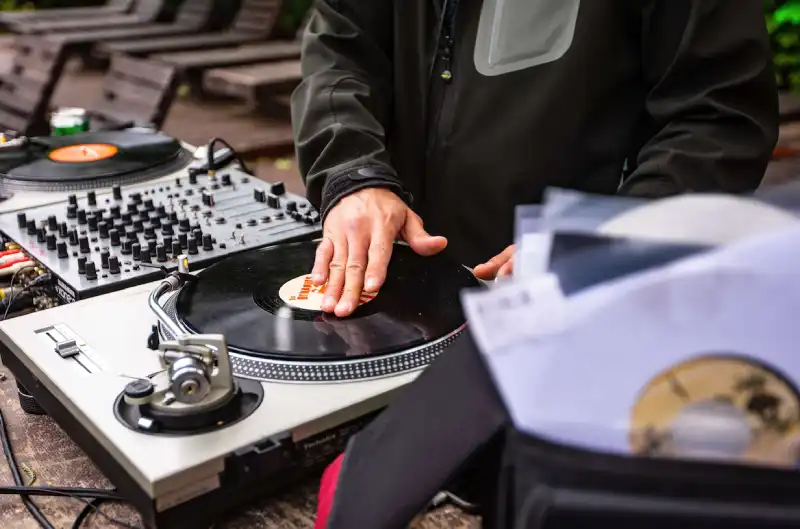Introduction
DJing is more than just playing music—it’s an art form that blends technical skills, creativity, and crowd connection. Whether you’re an aspiring DJ or looking to refine your craft, mastering the fundamentals and learning from industry pros can elevate your performances. This guide will provide essential tips and tricks to help you excel, from choosing the right equipment to reading the crowd like a seasoned DJ.

Understanding the Essentials: Equipment and Setup
Choosing Your Gear
To become a successful DJ, you need the right tools. Here’s what you’ll need:
- DJ Controller or Turntables – Controllers are beginner-friendly and versatile, while turntables offer a classic feel for vinyl lovers.
- Mixer – The heart of a DJ setup, used to blend tracks smoothly.
- Headphones – Quality headphones help with beatmatching and cueing.
- Laptop & DJ Software – Popular options include Serato DJ, Rekordbox, and Traktor.
- Speakers/Monitors – Essential for home practice and live performances.
Setting Up for Success
- Organize your music library with playlists and cue points.
- Ensure your equipment is properly connected and tested before performing.
- Keep backups of your tracks in case of technical issues.
Mastering the Basics: Beatmatching and Mixing
Beatmatching Without Sync
While the sync button can be helpful, professional DJs recommend learning manual beatmatching:
- Use your ears, not just waveforms, to match tempos.
- Adjust pitch sliders subtly to align beats.
- Use jog wheels to nudge the track into perfect sync.
Smooth Mixing Techniques
- EQ Blending – Use high, mid, and low frequencies to transition smoothly.
- Crossfader Control – Move it gradually for a seamless mix.
- Looping & Hot Cues – Set cue points for creative transitions.
🎶 Feel the Vibe with “By My Side” – A Must-Listen Track! 🎶
Get ready to immerse yourself in a mesmerizing blend of beats and melodies! “By My Side” delivers the perfect mix of energy and emotion, guaranteed to keep you hooked from start to finish. Whether you’re chilling or vibing on the dance floor, this track is a must-add to your playlist.
The Power of Song Selection and Set Planning
Understanding Your Audience
Great DJs don’t just play music—they tell a story. Tips for song selection:
- Read the crowd and adjust your setlist accordingly.
- Blend familiar hits with underground gems.
- Create energy waves by mixing high-energy tracks with smooth transitions.
Building a Setlist Like a Pro
- Start with a warm-up set to ease into the vibe.
- Introduce new elements progressively.
- Keep a backup playlist in case you need to change directions.
Advanced Techniques: Scratching, Effects, and Live Remixing
Scratching Basics
Scratching adds flair to your sets. To get started:
- Practice the baby scratch, the foundation of all scratching techniques.
- Experiment with crossfader cuts to create rhythmic patterns.
- Study legends like DJ Qbert and Grandmaster Flash for inspiration.
Using Effects Creatively
Effects can enhance your mixes when used correctly:
- Reverb and Echo – Smooth out transitions.
- Flanger and Phaser – Add movement and texture.
- Filters – Create build-ups and drops.
Live Remixing & Mashups
- Use acapellas to overlay vocals on instrumentals.
- Experiment with live looping to create unique sounds.
- Layer samples and drum loops for dynamic performances.
Reading the Crowd and Stage Presence
Engaging Your Audience
A great DJ knows how to connect with the crowd:
- Maintain eye contact and respond to their energy.
- Use a mic strategically to hype up the audience.
- Move naturally and express your passion for music.
Adapting to the Venue and Vibe
- Small clubs vs. large festivals require different energy levels.
- Be prepared to shift your playlist based on audience response.
- Watch body language—if the crowd isn’t reacting, switch up the style.
Branding Yourself as a DJ
Building an Online Presence
- Use Instagram, TikTok, and SoundCloud to share mixes.
- Create professional branding with a unique DJ name and logo.
- Engage with fans through live streams and Q&A sessions.
Networking and Getting Bookings
- Attend local events and connect with promoters.
- Submit your mixes to radio stations and DJ competitions.
- Build relationships with club owners and fellow DJs.
Conclusion
Becoming a successful DJ takes dedication, practice, and passion. By mastering the technical skills, reading the crowd, and building your brand, you can turn DJing into a thriving career or hobby. Keep learning, experimenting, and most importantly—have fun with it!
Are you ready to take your DJing to the next level? Start practicing these tips today and make every set unforgettable!